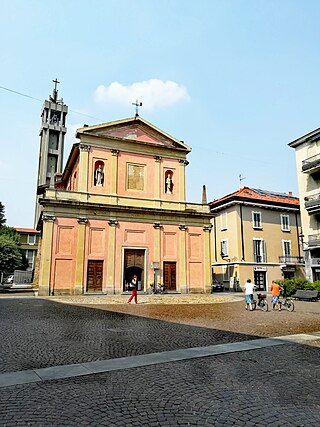
The Milan Metro is the rapid transit system serving Milan, Italy, operated by Azienda Trasporti Milanesi. The network consists of 5 lines with a total network length of 104.1 kilometres (64.7 mi), and a total of 113 stations, mostly underground. It has a daily ridership of about 1.4 million on weekdays. The Milan Metro is the largest system in Italy in terms of length, number of stations and ridership; and the seventh longest in the European Union.

Line 1 is the first underground rapid transit line built in Milan, Italy. It is part of the Milan Metro and it is operated by ATM. Works on the line began in 1957, and the first part was opened on 1 November 1964, running from Sesto Marelli to Lotto station. The line is also called Red Line, as it is visually identified by red signs. Due to its premiership, the line gave its red color to the Milan Metro logo.

Line 2, is a subway line serving Milan, Italy, operated by ATM as part of the Milan Metro. It is also called the Green Line,, as it is visually identified by green signs.

Line 3 is a subway line serving Milan, Italy. The line is part of the Milan Metro and is operated by ATM. Construction began in 1981 in order to be ready for the 1990 Football World Cup. It is also called the Yellow Line as it is identified by yellow signage.

Brianza is a geographical, historical and cultural area of Italy, at the foot of the Alps, in the northwest of Lombardy, between Milan and Lake Como.

Cernusco sul Naviglio is a town and comune in the Metropolitan City of Milan, Lombardy, northwestern Italy. With a population of 33,436 as of 2015 it is the 14th-largest municipality in the metropolitan city.

Cologno Monzese is a comune (municipality) in the Metropolitan City of Milan in the Italian region of Lombardy, located about 5 kilometres (3 mi) northeast of Milan. The population increased substantially after World War II, when many people from Southern Italy settled here.

Pioltello is a comune (municipality) in the Metropolitan City of Milan in the Italian region Lombardy, located about 7 kilometres (4 mi) northeast of Milan.

Cologno al Serio is a comune (municipality) in the Province of Bergamo in the Italian region of Lombardy, located about 45 kilometres (28 mi) northeast of Milan and about 10 kilometres (6 mi) south of Bergamo.

The Alfa Romeo Arese Plant was a plant area where Alfa Romeo had its head office for more than two decades prior to 1986. After Fiat Group purchased Alfa Romeo in 1986, Arese became one of the assembly plants of Fiat Group. The factory is in the Province of Milan in the Italian region of Lombardy, located about 12 kilometres (7.5 mi) northwest of Milan. The Arese plant replaced the old Alfa Romeo Portello factory and its construction was started in 1960 and took three years and until the end of the 1990s it was the biggest plant of Alfa Romeo covering a very wide area, partly in the territories of Lainate and Garbagnate Milanese. The factory became known as the Arese plant only because the main entrance is in the municipality of Arese.

Line 5 is an underground rapid transit line in Milan, Italy, part of the Milan Metro. The line, also known as M5 or the Lilac Line, is 12.8-kilometre (8.0 mi) long and goes through the city from the north to the north-west. It opened in stages between 2013 and 2015.

Line 4 is an underground rapid transit line in Milan, Italy, part of the Milan Metro. The line color is blue. The first section opened on 26 November 2022 and as of 2023 it is 7.3 km long with 8 stations. The full line is expected to open by 2024. Once completed, the line will be 15 km (9.3 mi) long with 21 stations.

Cascina Gobba is a station on Line 2 of the Milan Metro. The station is located on Via Padova at the west side of the A51 Milan bypass road. This is beside the major highway interchange known as Cascina Gobba, which is the main vehicular transportation hub of northeast Milan, Italy. The line branches here to terminate at either Cologno Nord or Gessate.

Cologno Sud is a suburban station on Line 2 of the Milan Metro in the municipality of Cologno Monzese.

Cologno Nord is a suburban station on Line 2 of the Milan Metro in the municipality of Cologno Monzese.

Cascina Antonietta is a station on Line 2 of the Milan Metro in the village of Cascina Antonietta, a suburb of Gorgonzola. It is the station with the lowest number of passengers in the system, with an average of 600 passengers per day in 2018.

Ca’ Granda-Pratocentenaro is a station on Line 5 of the Milan Metro.

Isola is a station on Line 5 of the Milan Metro. It takes its name from the Isola (island) district of Milan in which it is located, its name derived from the neighbourhood's position cut off from the city centre by the main railway.

The Metropolitan City of Milan is a metropolitan city in the Lombardy region of Italy. It is the second most populous metropolitan city in the nation after the Metropolitan City of Rome Capital. Its capital is the city of Milan. It replaced the province of Milan and includes the city of Milan and 132 other comuni. It was first created by the reform of local authorities and then established by the Law 56/2014. It has been operative since 1 January 2015.


















